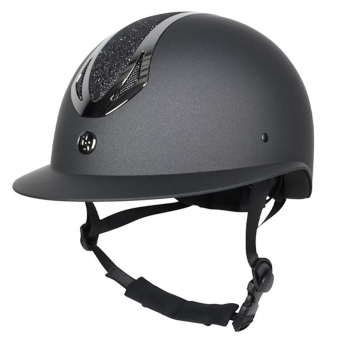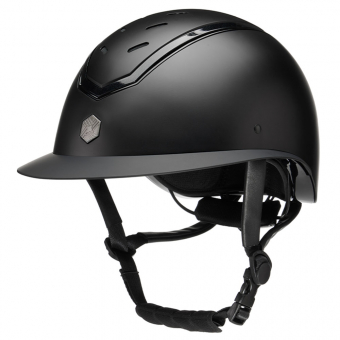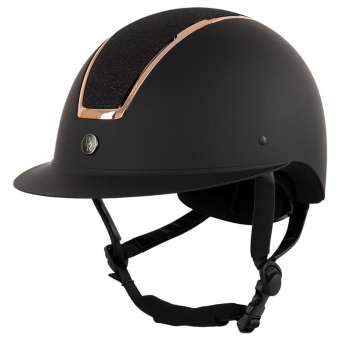Finding a good and safe riding helmet doesn't have to be difficult. All riding helmets in our wide range are both CE-marked and VG1-approved, which means you don't have to worry about the safety of your choice. With us, you can instead focus on what you find stylish and what suits you best.
A Approved Riding Helmet for Competition - Whichever You Choose in Our Range
A riding helmet can be crucial in the outcome of an accident. Using a helmet in all equestrian disciplines is a must, especially during competitions when it is a requirement. Safety markings for riding helmets are in place to ensure that you, as a rider, have adequate protection when using your helmet.
A riding helmet is considered personal protective equipment, and the basic rule for it is that it should be CE-marked. CE marking is a manufacturer's certification indicating that the helmet complies with the EU's basic safety requirements. In addition to CE marking, there are various additional markings that indicate the product meets a specific standard. VG1 is an example of such an additional marking. VG1 certification indicates that the riding helmet has been tested according to a certain standard.
All our riding helmets are CE-marked and VG1-approved, meeting the standard requirements for competition use. More information about the rules can be found with the Consumer Agency and the Swedish Equestrian Federation.
How Should a Riding Helmet Fit?
- Your riding helmet should fit comfortably. It's essential that it's not loose, but it shouldn't be too tight and cause discomfort.
- The riding helmet should protect your forehead, temples, and the top of your head down to the neck, covering the entire skull.
- The visor should be level, neither too high nor too low towards your eyes.
- The helmet should stay securely in place and not be able to shift out of position.
Riding Helmet - Size and Fit
The size of the helmet is specified in centimeters and refers to the circumference of your head. Measure your helmet size by measuring around your head, just above your eyebrows, using a measuring tape. The measurement in centimeters corresponds to the size you should have for your riding helmet. For example, if your head measures 58 cm in circumference, you should choose a size 58 helmet.
Some riding helmets are rounder in shape, while others are more oval. This means that some helmets may fit you better or worse, depending on the shape of your head. Most modern riding helmets adjust well to your head shape because they have adjustable inserts and liners that mold to your head. For optimal comfort, you can change the liner or settings on the helmet to ensure it fits you well. Samshield and KEP Italia are just a couple of our popular brands that offer customization in this way.
How to Properly Fit Your Riding Helmet:
- Put on the helmet without fastening it. Bend your neck forward and shake your head to check the size and fit. The helmet should stay in place and not move if it fits correctly. This can also be verified by standing upright and gently rocking the helmet back and forth with your hands. If you use the latter method, the skin on your forehead should move with the helmet for a proper fit. If the helmet moves independently on your head, it is either too large or the shape is too round or oval for your head.
- Once you've found a helmet that fits your head, adjust the chin strap so that it sits snugly under your chin against your neck. When you can fit one finger between the strap and your neck, it is properly tightened.
- If your riding helmet is adjustable, tighten or loosen the adjustment in the back of the helmet to make it comfortable.
- Adjust the 5- or 3-point harness so that the junction where the straps meet is just below your ear.
How Long Does a Riding Helmet Last?
Generally, it is recommended to replace a helmet every 3 years. This is because the plastic used in the helmet has a limited lifespan and an expiration date. After about 3 years, the impact-absorbing material deteriorates, becoming dry and less elastic, resulting in reduced energy absorption from an impact. Therefore, a riding helmet does not provide the same level of protection after a few years, even if it has never been involved in an accident or taken any direct blows. To extend the durability of your riding helmet, always follow the care and maintenance instructions included with the helmet, and store it in a dry, clean place, preferably on a helmet hanger, away from direct sunlight. You should also use a protective bag or helmet bag when packing or carrying your helmet to the stable.
How Often Should You Replace a Riding Helmet?
As mentioned above, it's recommended to replace your helmet every approximately 3 years. However, if you have fallen off a horse, and your riding helmet has taken an impact, we recommend replacing it immediately. After an impact, the technology in the helmet is compromised, and its resistance to future impacts is not as effective. This means your protection is no longer optimal. From the outside, you cannot see the condition of the helmet's interior, which is why you should always replace your riding helmet after a fall where you hit your head.
For the reasons mentioned above, we also do not recommend buying a used riding helmet. You do not know what that helmet has been through.
Stylish Riding Helmets for Kids and Juniors as well as Ladies and Men
Regardless of whether you need a riding helmet for dressage, jumping, or another equestrian discipline, safety always comes first. The helmet should also be suitable for the specific discipline you are participating in. For example, in eventing, it is not allowed to have a visor on the helmet for safety reasons. But style matters too, not least to add a personal touch to your gear and create a cohesive look for your riding ensemble.
In dressage, a classic velvet dressage helmet or a helmet with bling may be an elegant choice, while in the show jumping arena, it's more common to see colorful helmets in shades like rose gold, pink, or with glitter. It may come as no surprise that black and brown are the most common colors for riding helmets.
Whatever you need, you can be sure to find a safe riding helmet that fits both your shape and style - whether it's for children or juniors, as well as for adult ladies and gentlemen. We have a wide range of stylish and affordable riding helmets from leading brands such as Hansbo Sport, Charles Owen and Back on Track, making it easy for you to find the best riding helmet for you.































